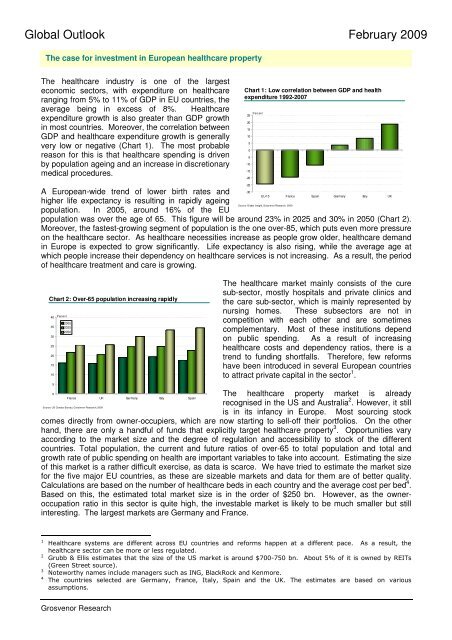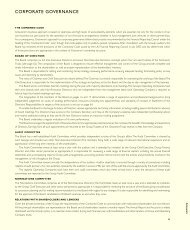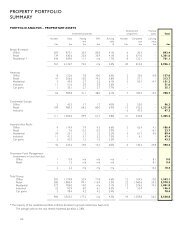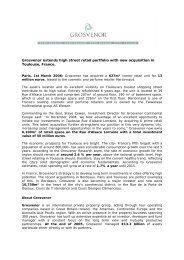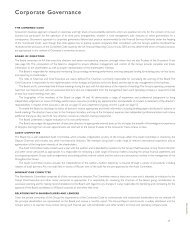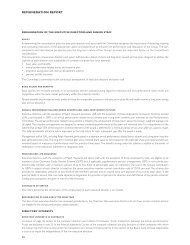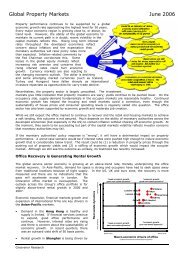Global Outlook February 2009.pdf - Grosvenor
Global Outlook February 2009.pdf - Grosvenor
Global Outlook February 2009.pdf - Grosvenor
You also want an ePaper? Increase the reach of your titles
YUMPU automatically turns print PDFs into web optimized ePapers that Google loves.
<strong>Global</strong> <strong>Outlook</strong> <strong>February</strong> 2009<br />
The case for investment in European healthcare property<br />
The healthcare industry is one of the largest<br />
economic sectors, with expenditure on healthcare<br />
ranging from 5% to 11% of GDP in EU countries, the<br />
average being in excess of 8%. Healthcare<br />
expenditure growth is also greater than GDP growth<br />
in most countries. Moreover, the correlation between<br />
GDP and healthcare expenditure growth is generally<br />
very low or negative (Chart 1). The most probable<br />
reason for this is that healthcare spending is driven<br />
by population ageing and an increase in discretionary<br />
medical procedures.<br />
Chart 1: Low correlation between GDP and health<br />
expenditure 1992-2007<br />
25<br />
20<br />
15<br />
10<br />
5<br />
0<br />
-5<br />
-10<br />
-15<br />
-20<br />
Percent<br />
A European-wide trend of lower birth rates and -30<br />
EU-15 France Spain Germany Italy UK<br />
higher life expectancy is resulting in rapidly ageing<br />
Source: <strong>Global</strong> Insight, <strong>Grosvenor</strong> Research, 2009<br />
population. In 2005, around 16% of the EU<br />
population was over the age of 65. This figure will be around 23% in 2025 and 30% in 2050 (Chart 2).<br />
Moreover, the fastest-growing segment of population is the one over-85, which puts even more pressure<br />
on the healthcare sector. As healthcare necessities increase as people grow older, healthcare demand<br />
in Europe is expected to grow significantly. Life expectancy is also rising, while the average age at<br />
which people increase their dependency on healthcare services is not increasing. As a result, the period<br />
of healthcare treatment and care is growing.<br />
Chart 2: Over-65 population increasing rapidly<br />
40<br />
35<br />
30<br />
25<br />
20<br />
15<br />
10<br />
5<br />
Percent<br />
2005<br />
2025<br />
2050<br />
The healthcare market mainly consists of the cure<br />
sub-sector, mostly hospitals and private clinics and<br />
the care sub-sector, which is mainly represented by<br />
nursing homes. These subsectors are not in<br />
competition with each other and are sometimes<br />
complementary. Most of these institutions depend<br />
on public spending. As a result of increasing<br />
healthcare costs and dependency ratios, there is a<br />
trend to funding shortfalls. Therefore, few reforms<br />
have been introduced in several European countries<br />
to attract private capital in the sector 1 .<br />
0<br />
The healthcare property market is already<br />
France UK Germany Italy Spain<br />
recognised in the US and Australia 2 . However, it still<br />
Source: US Censes Bureau, <strong>Grosvenor</strong> Research, 2009<br />
is in its infancy in Europe. Most sourcing stock<br />
comes directly from owner-occupiers, which are now starting to sell-off their portfolios. On the other<br />
hand, there are only a handful of funds that explicitly target healthcare property 3 . Opportunities vary<br />
according to the market size and the degree of regulation and accessibility to stock of the different<br />
countries. Total population, the current and future ratios of over-65 to total population and total and<br />
growth rate of public spending on health are important variables to take into account. Estimating the size<br />
of this market is a rather difficult exercise, as data is scarce. We have tried to estimate the market size<br />
for the five major EU countries, as these are sizeable markets and data for them are of better quality.<br />
Calculations are based on the number of healthcare beds in each country and the average cost per bed 4 .<br />
Based on this, the estimated total market size is in the order of $250 bn. However, as the owneroccupation<br />
ratio in this sector is quite high, the investable market is likely to be much smaller but still<br />
interesting. The largest markets are Germany and France.<br />
-25<br />
1 Healthcare systems are different across EU countries and reforms happen at a different pace. As a result, the<br />
healthcare sector can be more or less regulated.<br />
2 Grubb & Ellis estimates that the size of the US market is around $700-750 bn. About 5% of it is owned by REITs<br />
(Green Street source).<br />
3 Noteworthy names include managers such as ING, BlackRock and Kenmore.<br />
4 The countries selected are Germany, France, Italy, Spain and the UK. The estimates are based on various<br />
assumptions.<br />
<strong>Grosvenor</strong> Research
<strong>Global</strong> <strong>Outlook</strong> <strong>February</strong> 2009<br />
Chart 3: Germany is the largest market<br />
$ bn<br />
140<br />
120<br />
100<br />
80<br />
60<br />
40<br />
20<br />
0<br />
Spain UK Italy France Germany<br />
Source: WHO, <strong>Grosvenor</strong> Research, 2009<br />
Compared with standard commercial property,<br />
healthcare property vacancy and rental rates are less<br />
likely to exhibit the peaks and troughs of the property<br />
cycle. Healthcare property can offer attractive<br />
income returns. Although our analysis is limited by<br />
data availability, anecdotal evidence suggests that<br />
yields are relatively high, when compared to the main<br />
commercial sectors. This is hardly surprising, given<br />
the higher risk implied by this type of investment.<br />
Prime yields should range are expected to be<br />
between 7.0% and 9.0% for this kind of product.<br />
Moreover, the healthcare market in Continental<br />
Europe is characterised by long leases and offers<br />
indexation, albeit maybe not at full rate.<br />
As mentioned, investing in healthcare property is not, however, exempt from risks. The sector is still<br />
quite illiquid and lack of transparency maybe an issue as legislation and regulation are rather different<br />
across European countries. A specific risk of this sector is mismanagement risk, as it carries a severe<br />
reputational risk. On the other hand, re-letting risk may be mitigated as a result of government concern<br />
about continuity of services. These types of properties are also generally located in good central or<br />
countryside locations, making it easier to change the use of the building.<br />
This document is for general informative purposes only. The information has been compiled from sources believed to be reliable however its accuracy and<br />
completeness are not guaranteed. The opinions expressed are those of the Research Department of <strong>Grosvenor</strong> Group Limited ("<strong>Grosvenor</strong>") at this date<br />
and are subject to change without notice. Reliance should not be placed on the information, forecasts and opinions set out herein for any investment<br />
purposes and <strong>Grosvenor</strong> will not accept any liability arising from such use. This document is intended for professional and non-private investors only. No<br />
part of this publication may be reproduced in any form without the prior written permission of <strong>Grosvenor</strong>.


